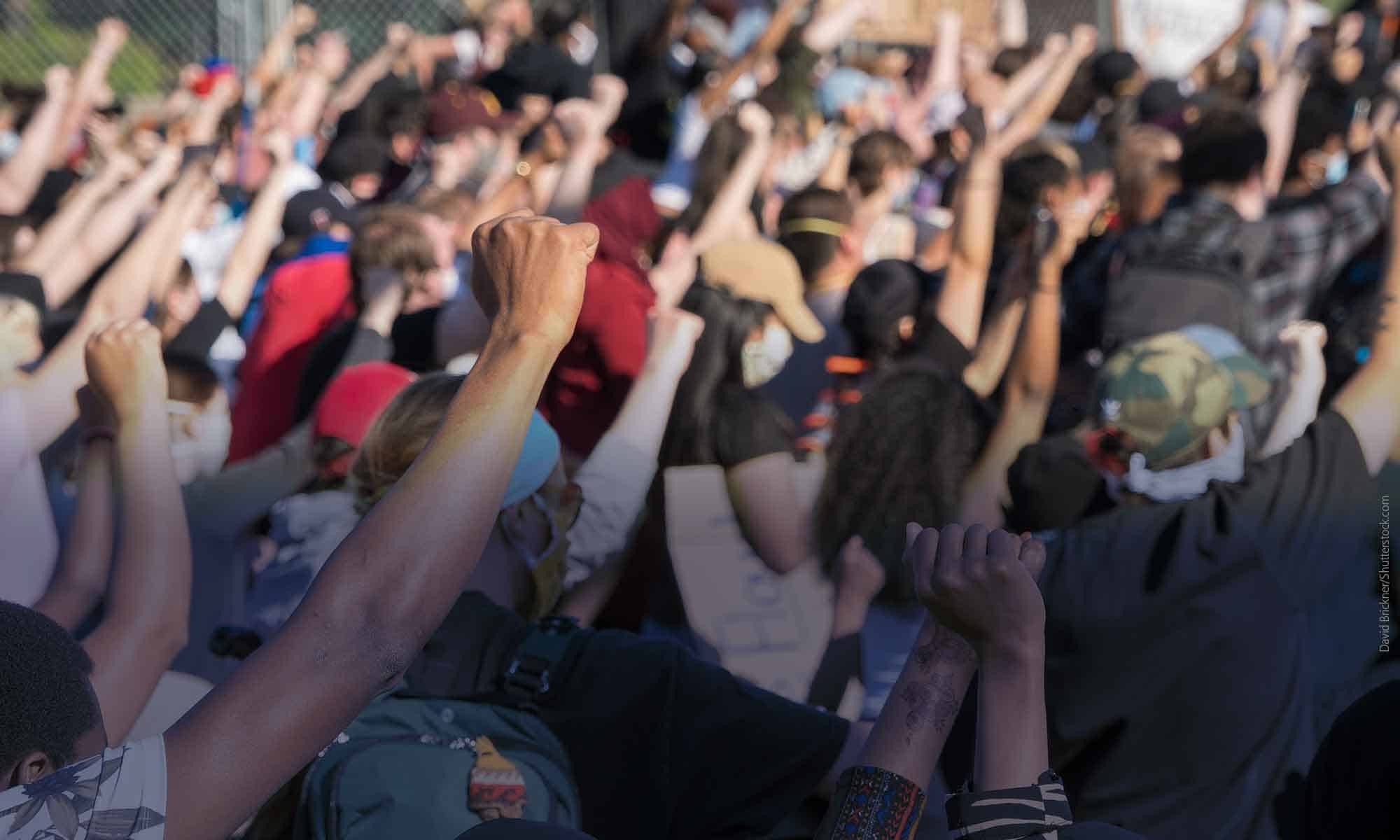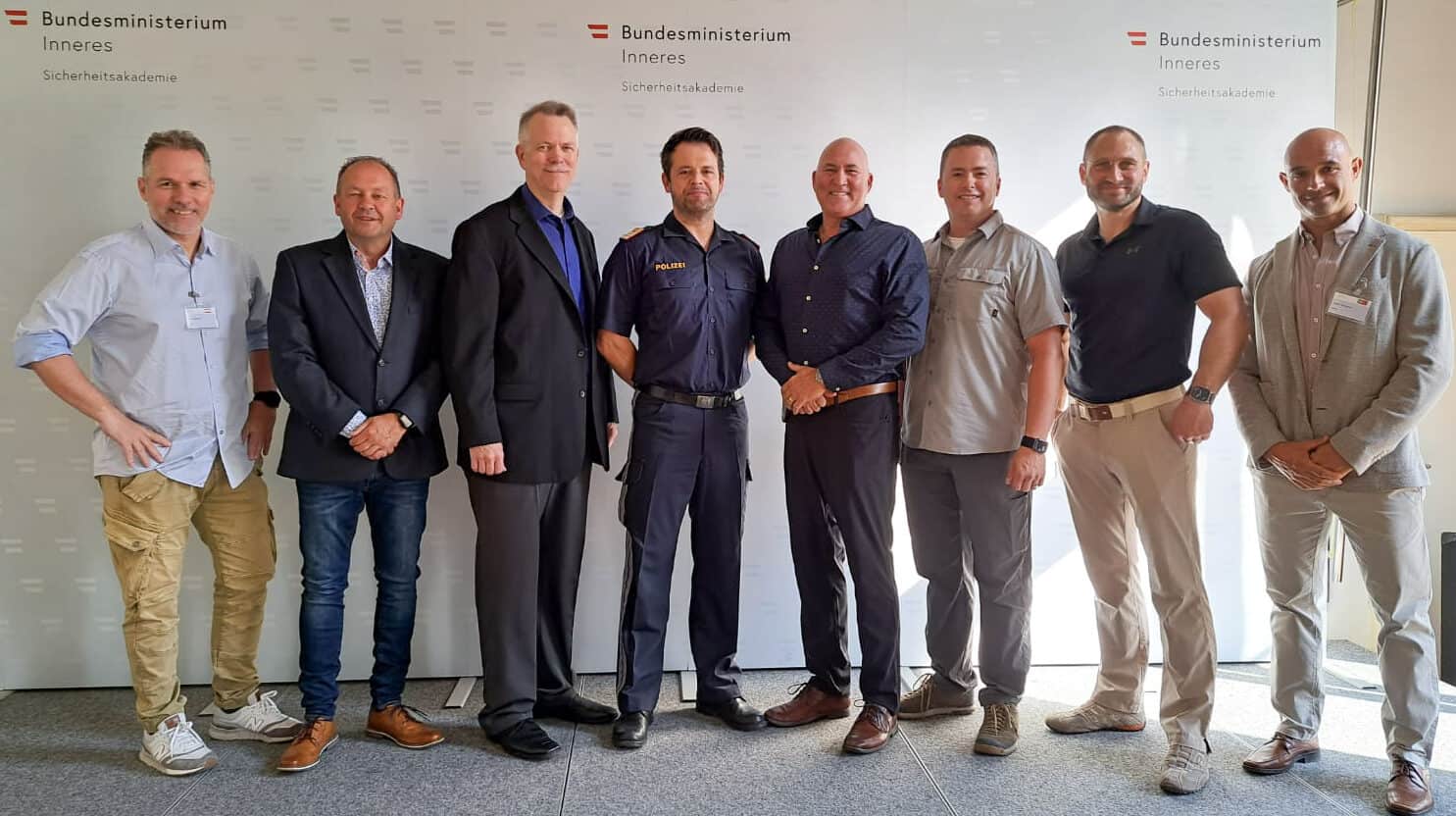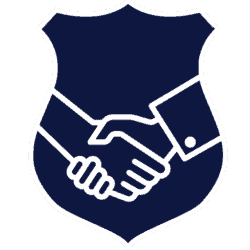In June 2023, the Austrian Sicherheitsakademie (SIAK, Education and research institution of the Federal Ministry of the Interior, Austria) hosted an international Workshop on Public Order, Crowd Management and Riot Control. The responsible organizer, Chief Insp. Thomas Greis, welcomed 7 international speakers and around 100 subject matter experts from 14 nations in Vienna to this 3-day information-packed program.
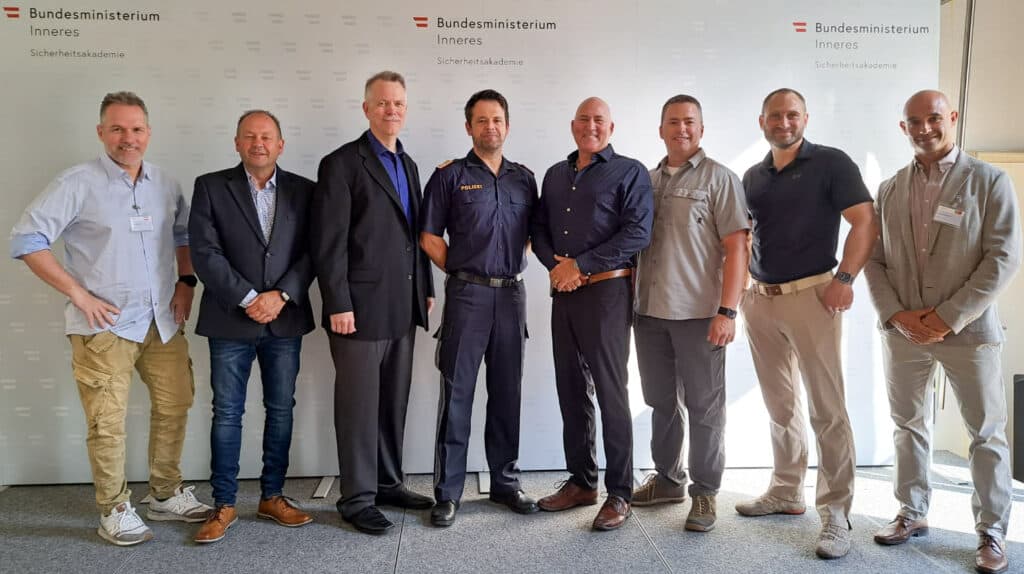
As the Austrian representative, Colonel Ernst Albrecht (Vienna Regional Police Directorate, ASE WEGA, Austrias “Advanced” Public Order Unit) introduced the structure of the various units that are deployed by the Police for large scale crowd operations. He also tried to familiarize the attendees with the “3-D philosophy” (Note: Dialogue – De-escalation – Enforcement), which is successfully applied in Austria, and at the same time to explain which, which of the introduced units are trained and equipped for which level. Finally, the contents were framed by the presentation of various operational videos of the WEGA.
From the United States of America (USA), Captain Alan Hanson (Fairfax County Police Department) gave a presentation on the current standard of the American Public Order Policing as well as the status of the necessary equipment and operational tactics. To further improve these topics, a working group was set up in 2014, which traveled to Europe and obtained information from the British and German police authorities, among others. The American colleagues were particularly impressed by the clear definition of standards for protective equipment and various operational tactics, which have proven themselves over decades. Among other things, the “Public Order Response and Operation Standard”, which can be regarded as the American Public Order Policing guideline, was developed from this knowledge. He also gave insights in cross-border police cooperation since each state and even counties in America often have different laws and police authorities, but regularly need to assist each other. This mutual aid is regulated in the EMAC (Emergency Management Assistance Compact), which makes it easier to request or coordinate units across state borders during large-scale operations or crises. He demonstrated these procedures, their benefits and challenges with practical examples like the Baltimore City Riots in 2015 and storming of the US Capitol).
Colonel Dr. Bernd Bürger (Germany, Institute for further education of the Bavarian Police) talked about the necessary Mindset for Public Order Policing. He shared insights into the topic of mass psychology and explained why and how police should use this for their strategy and tactics. In particular, Dr. Bürger addressed the issue of how each individual police officer and police leaders can and should prepare themselves, especially mentally, for upcoming missions. The mental examination of possible scenarios and developments alone, as well as an independent examination of current issues surrounding the topic of assemblies, expands the awareness of each individual and the (mental) ability to react in the field enormously. For example, Dr. Bürger pointed out that police needs to be aware, that crowds at large gatherings are not composed of one large community with the same interests and attitudes, but of many different ones. And neglecting that by treating the whole crowd the same (like the few perpetrators) is most likely the cause for those originally different groups within a crowd to feel like one (psychological) crowd – an effect that can be called solidarization and which will often is the starting point for a event to deteriorate.
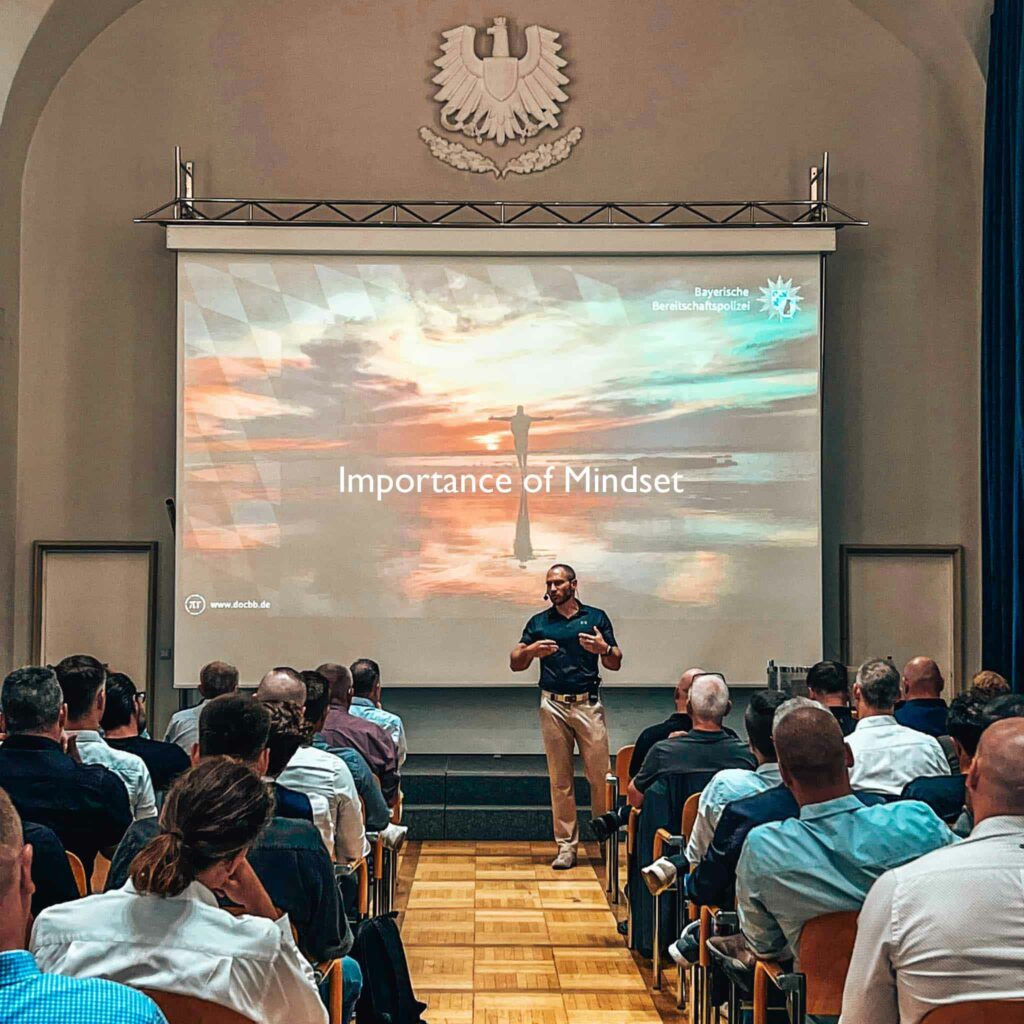
The Dutch representative, Chief Superintendent Paul Moss (Police Academy of The Netherlands) led the audience through the structure of the law enforcement police in a very interesting and pictorial presentation. He explained how the education and training for such units is regulated. A major focus of the Dutch police are coordinated regular exercises of all kinds of different police units. On each “practice Thursday” they come together and practice to help a friction-free and efficient cooperation in the field.
Captain Brian Bixler of the Los Angeles Police Department kept the audience entertained by sharing his thoughts on, among other things, the physically and mentally challenging “Riots After the Death of George Floyd”. He presented the social and tactical challenges faced by the entire Los Angeles police. At the same time he was very candid and explained that the LAPD had very rudimentary public order tactics at the time and that they were adjusted as a result of the events. The presenter introduced the new system of how such phenomena can be assessed and managed by police, focusing on the the special role of police leadership at different levels in making decisions (perfectly complementing the presentation of Dr. Bürger) . Are the orders clearly formulated? What are the consequences of my decision? Can I keep a clear head even in dynamic situations? How do I deal with a plurality of operational localities?
He also gave insights into the LAPD’s mounted police and their capabilities at public order events and presented the Tactical Response Force (TRF) as a very efficient tactical component that makes targeted arrests of suspects which can be also deployed at large-scale crowd operations.
Colonel Pedro Nogueira from Portugal (Guarda Nacional Republicana, GNR) gave a deep insight into the organization of this police-military unit, which is deployed throughout the country and is divided into 4 different levels of intervention. The 3rd level of response it the Public Order Intervention Group which is stationed in Porto, Lisbon and Faro. To join this unit, a rigorous selection process including performance tests must be completed. Ongoing training and performance tests help keep officers fit and assertive. He also gave an overview of recent developments in the area of violent protesters and how they confront police tactics and equipment. Among other things, he presented the 2019 truck drivers’ strike in Portugal, which is using their heavy trucks to block major thoroughfares
Captain Franz Schöning from the USA (Portland Police Department, Oregon) started his presentation “100 Days of Portland Protests from May 2020 to July 2020” with an overview of the organization and structure of the Portland Police Department. He explained that the city already had multiple experiences with demonstrations with potential for violence. The police department also had to learn a lot in public relations. The Portland Police Department now has specially trained dialogue police officers.
Turning to the 2020 protests, months earlier public opinion toward the police began to shift: Concerns about police bias and legitimacy grew. Images and stories (often intentionally distorted) emerged on social media, combined with enormous attention from international media regarding the local protests. Over time, these views led to a perception within the police that working in law enforcement was a “career killer.” In addition, the authorities had not invested in the Rapid Response Team (RRT, the unit is, among other things, specialized on targeted arrests of people prepared to use violence in large-scale events) for some time. On May 25, 2020, G. Floyd was killed in the line of police duty and the first riots broke out in the city. Approximately 100 days of civil unrest followed throughout the Portland, Oregon metropolitan area. Captain Schoenig explained that conversation with the protesters did not go as desired, basically there was no communication at all. Many protesters were extremely well-organized and made tactical measures enormously difficult for the police. The local police’s ability to handle those events with its own forces posed a particularly great challenge. Likewise, judicial or political decisions sometimes made (cooperative) work with support forces from the federal police or fire department impossible. The Federal Police, now deployed as support, did not consider themselves bound by local law and invariably enforced federal law, which further worsened the situation in relation to the protesters. Any support provided by the State Police and surrounding Sherifs was contingent on the use of tear gas (CS), which was not released by the agency. To make matters worse, on Day 93 of the protests, a “Trump truck rally” was held with approximately 900 vehicles, with clashes between left-wing and right-wing groups feared.
After the judiciary brought charges against members of the RRT, all members of this unit resigned on June 17, 2020. Captain Schoening then spoke about the lessons learned and what should be considered for future police situations of this kind and what should be included in the considerations regarding operational tactics:
The good organization of the counterpart, use of lasers against police officers, psychological effects by leaf blowers, signs, paint bags, pyrotechnics, etc. on the units; use of vehicles and caltrops to interrupt transport and supply routes of the police; officers were insulted by demonstrators on their way to or from the office and sometimes needed protect themselves at the change of shifts, etc. This stressful circumstance led to psychological and social consequences for a majority of police officers. Families and friendships often broke down due to the immense pressure of duty as well as the differences of opinion among the population.
Finally he talked about the embedding of firefighter-paramedics (“embedded fire medics”). These are members of the fire department who can volunteer for service in the public order police. There they deployed exclusively in this function (medical concerns or fire fighting) within the police units. They have their own uniform and protective equipment. In this way, police officers can remain assigned to their primary task, and cooperation and understanding between the organizations is also fostered.
Many lessons in the field of equipment, training, command structure but also communication on all channels available to the police were learned from this operation, which have since been implemented accordingly.
Thank you very much SIAK and especially Thomas Greis, for organizing and hosting this great event!
Published with kind permission of the organizer.
Find an article with more images and in german language here.
